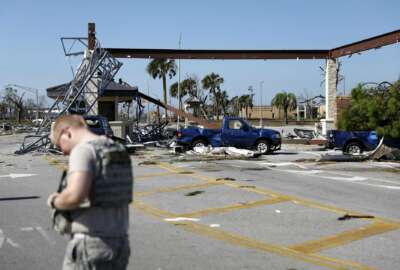Best listening experience is on Chrome, Firefox or Safari. Subscribe to Federal Drive’s daily audio interviews on Apple Podcasts or PodcastOne.
After Hurricane Michael ravaged the Florida coast, Tyndall Air Force Base is left completely uninhabitable, and the Air Force still is not sure where it will temporarily send or station the 3,600 airmen and their families who live on the base.
“Utter devastation” is how Gen. Joseph Lengyel, the National Guard Bureau chief, described the base and surrounding cities to reporters Friday in Washington.
Water, power and cellular services in the area are not working.
“One hundred percent of that base is uninhabitable,” Lengyel said. “All of the families, thankfully, were evacuated out of there. That response will be run by the United States Air Force on how to mitigate that. It’s a big destructive force that came through.”
Lengyel said Hurlburt Field and Eglin Air Force Base, also on the Florida panhandle, were mostly spared from the disaster.
“The initial concern right now is for the families and the people who were displaced from that,” Lengyel said. “I don’t think they can live on Tyndall, plus the schools and the rest, so there’s a lot to do with how they begin to mitigate the disaster that happened there.”
As of now, Lengyel said he is unsure where the Air Force will send the displaced airmen and their families.
Tyndall is known as a training ground for F-22 pilots. The 50 fighter jets that reside on the base were moved out of harm’s way before the storm hit.
Other military and government buildings across the south are closed due to the storm.
As for the total area affected by the hurricane, Lengyel said there are 3,655 soldiers and airmen providing relief in Florida and Georgia.
There are also an additional 10,500 troops that can be called in from surrounding states if needed. However, Lengyel said he didn’t think they would be necessary.
The troops set up 11 different distribution points for water and food and are currently assisting in debris removal, search and rescue missions and aiding law enforcement.
A pattern of hurricanes
Lengyel told reporters it seemed that larger, more devastating storms like Hurricanes Florence and Harvey over the past two years are becoming more frequent.
However, the National Guard is not feeling the stress too much, despite being deployed for everything from wildfires to drug busts to Afghanistan and Iraq.
“I think that the structure that we have and the Guard as a dual use force is about as efficient as we can get,” Lengyel said.
The National Guard has about 450,000 people, but only about 10 percent are used, Lengyal said.
Even during last year’s unusually chaotic hurricane season, the National Guard only had to call up about 45,000 troops.
“We are an operational force and we are busier than we used to be and there are signs that 39 days a year is no longer the message we want to send about how much we train,” Lengyel said. “We are always out there doing something and it’s a different force than it was 25 years ago, for sure. But I don’t think we are stressed to the extent where you need a separate domestic operations force.”
Copyright
© 2024 Federal News Network. All rights reserved. This website is not intended for users located within the European Economic Area.
